It began in May with a queue of people spilling out onto the street off a narrow footpath outside a boutique coffee shop in Blackrock village. With two lanes of moving traffic, and cars parked along the street, there was a risk of an accident as people tried to both buy their coffee while remaining socially distant.
Dún Laoghaire-Rathdown County Council (DLRC) decided to take back a few car parking spaces near the cafe and use the area to allow people to purchase their drinks more safely.
It was the first move that would ultimately see the council take swathes of space once used for cars in five different places in villages across south county Dublin in order to allow people to safely access their local businesses.
This turned into a longer project – one that radically reimagined a stretch of south Dublin coastline stretching from Blackrock to the historic Forty Foot in Sandcove, a favourite bathing spot for Dubliners for 250 years.
In just a couple of months, a new coastal mobility route has been built that hugs the coast. Streets that required cars and cyclists to zigzag around each other have become one way to make way for a new cycle lane. It has made the streets less dominated by cars and opened the opportunity to enjoy views of the sea.
New pocket parks are being planned too, street furniture has been installed, plants have replaced cement car parks.
There are similar projects taking place in Dublin city centre, Galway, Cork and many towns and villages around the country, but DLRC has been at the forefront of what could be a new way of viewing urban living. In a matter of weeks, the council has used Covid-19 to push through changes that have been talked about for decades.
There has been some resistance and complaints, but also a growing swell of support. So far, it is all being done on a temporary basis. But will people want to go back?
Is this start of a different approach to living that could prove a model for other towns and villages?
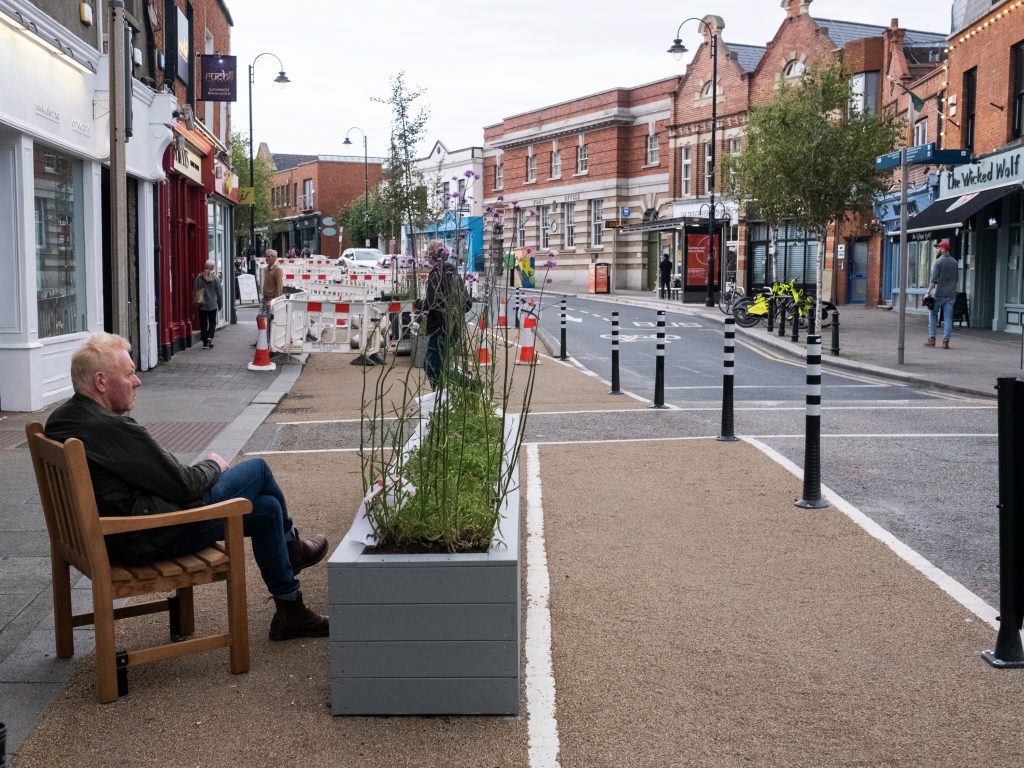
*****
Robert Burns meets me outside Dún Laoghaire Rathdown County Council’s headquarters overlooking the Dart station and beyond the East and West piers. His title is quite the mouthful: director of infrastructure, sustainable mobility, and climate change.
It is a role Burns has taken to with gusto since he joined the council in 2018 after previously working in-house as a senior executive engineer with Clare County Council.
Burns has organised two electric bikes for us, out of 20 recently acquired by the council.
We spend the next two hours cycling and stopping to talk as we tour the new coastal mobility route that has sprung up since Covid-19. It is a dull day with an occasional gust of rain, not an untypical one for Ireland.
“We want healthy liveable places that are centred around people.”
Robert Burns
Shane Lynam, a photographer, joins us. Lynam’s work has appeared in The New York Times and Forbes and he has exhibited in the RHA. He is also a keen cyclist who lives in an apartment overlooking Sea Point, so he’s watched the cycle lanes change his home environment.
It is not hard to convince him to join us. “I’m able to open the windows at the front of my home for the first time,” he says. “There is so much less noise and pollution.”
The three of us head down on our bikes towards Sandycove on a new bike lane. Ecoflex, a Roscommon subcontractor, has laid down a buff-coloured anti-skid surface on much of the route. It can lay about 150 metres per day, weather permitting, and is gradually working its way along the coastal mobility route.
The day of our journey is grey and drizzly. The perfect weather to test just what is happening.
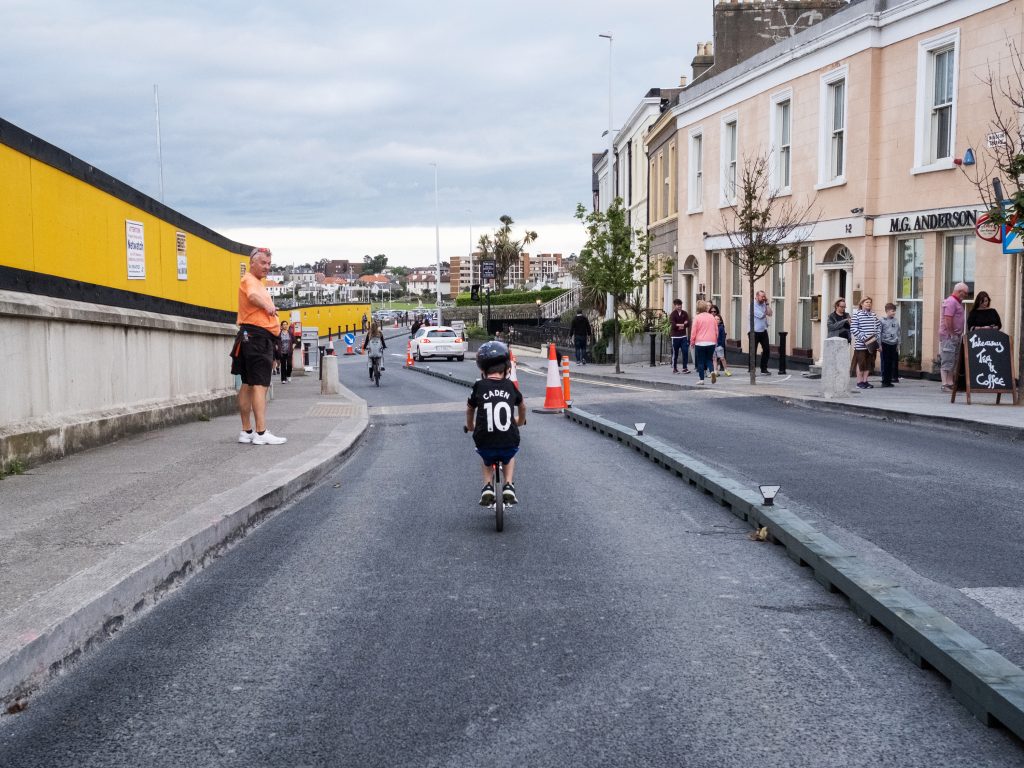
We cycle past the entrance to the East pier to stop at a point near the construction of the new Dún Laoghaire Baths, which overlooks Scotsman’s Bay to Sandycove Harbour.
The baths closed in the mid-1990s and fell into dereliction for the next 20 years. It was a long way from when the baths opened in 1843 as the Royal Victorian Baths and, for the next 150-odd years, were beloved by Dubliners.
The new €9 million plan for the site will see it rebuilt as a studio space for artists, a gallery and a cafe terrace. A new sculpture of Roger Casement, the nationalist and human rights campaigner, who was born in Sandycove, has been commissioned for the site.
“When this project is completed it will really open up the seafront,” Burns says, adding that Covid-19 caused construction to be halted for a few months, so its completion date has been pushed out to 2021 from 2020.
DLRC has also relocated a Sunday farmer’s market in Dún Laoghaire’s People’s Park to a civic space around the DLR Lexicon Library. Burns says that roughly 50 small businesses who traded in the market could reopen in a location where it was easier to social distance.
Burns points towards a walking and cycling route called The Metals, which starts from the People’s Park and runs all the way to Dalkey.
This route dates back to the 1840s when it was used to carry granite from Dalkey quarry to Dún Laoghaire to build the East and West piers. He says the council planned to link the coastal mobility route to The Metals to allow people switch between either route more easily.
“We do know that one of the blockages for cyclists is safety and that has come out in our surveys. The minute you improve safety more cyclists come,” he says.
“We don’t really need to analyse it that much. All you have to do is see what happens. The profile of users change. We have young, old, people with mobility challenges, wheelchairs, hand-trikes, young children, parents with buggies all using this route now. That is proof they feel safe.”
DLRC took over the Dún Laoghaire piers recently from the former Dún Laoghaire Harbour Company. The company had been in financial difficulties for years, partly due to the cost of having to repair the piers after severe storms.
“A lot of what we are doing now probably would not have been possible without us having control of the harbour,” Burns says.
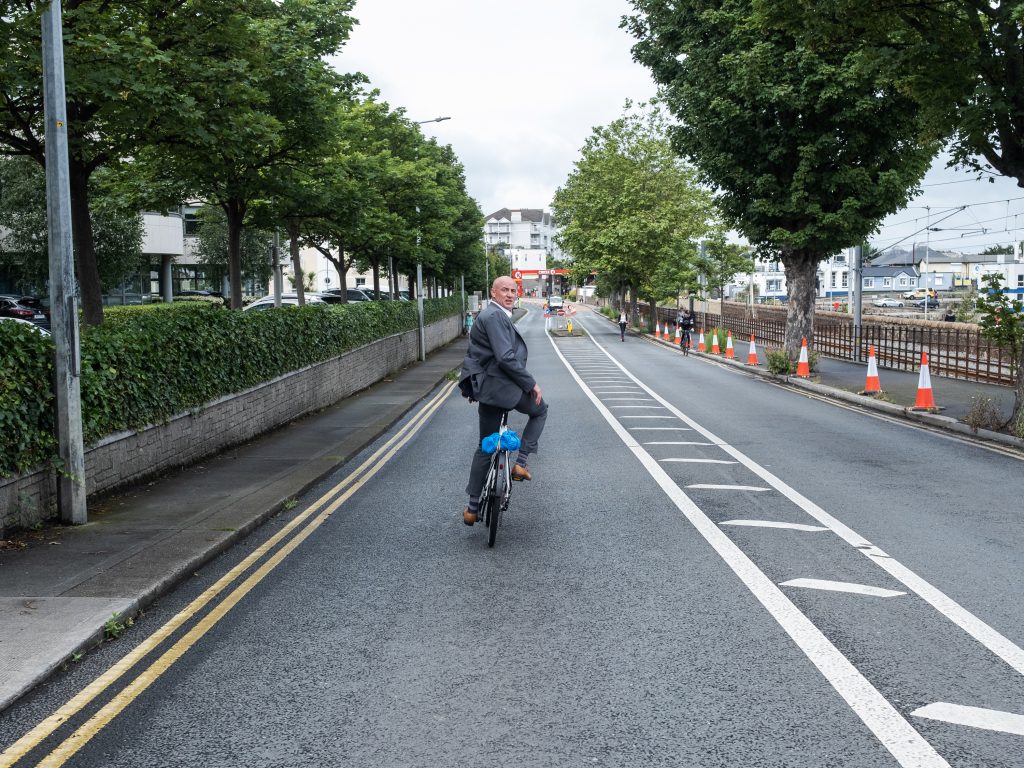
He says the council needed to use some of its facilities to build the mobility route, so having control of the area allowed it to move fast.
Burns says DLRC plans to work with a third-level institution to carry out research to measure the impact of the new mobility route. “We want to look at the economic, traffic and social impact of these changes,” he says. “And we haven’t even started to look at the environmental and health benefits.
“The thing about active modes of travel is there is less pollution, there is less noise which is a real benefit to the town and residents. While we might have started off looking at Covid-19 in terms of mobility and safety and helping business reopen, we can see there is much more at stake.
“There may be a virtue from Covid if it helps us transition to a more sustainable way of living. We want healthy liveable places that are centred around people.
“That is the focus of our interventions here [on the mobility route] and in the villages. The person is at the centre of everything.”
A concern expressed by some shop owners is that cyclists and walkers shop less, and don’t buy larger goods as they can’t carry them.
“I am not sure that has been established,” Burns says, adding that Transport for London research carried out by University College London found the opposite.
This report concluded: “People walking, cycling and using public transport spend the most in their local shops, spending 40 per cent more each month than car drivers.”
Burns says larger items that could not be easily carried could be delivered instead. “There are a lot of presumptions about cyclists and pedestrians,” Burns said. “It is pedestrians who buy things not motorists.
“Another phenomenon we’ve seen is that some people visited their local village only once a week but now they can now do it more regularly. They are buying things but also doing other stuff like eating out.”
“It was like dealing with a fire or a burst pipe. We didn’t get to talk about it for weeks… We just had to do it.”
Robert Burns
Burns says private bike companies like Bleeperbike and Moby Bikes have relocated more bikes onto the coastal route to allow their members access them easily from Dart stations along the route.
“What I would expect to see soon is bike hire. It is something we may facilitate ourselves with a pop-up facility,” he says. “A mobility corridor is like an artery for economic activity and investment.”
He cites the Waterford Greenway, which was used by 250,000 people in its first nine months, as an example of the kind of economic activity that can be generated as travellers booked into accommodation along the route or stopped to spend.
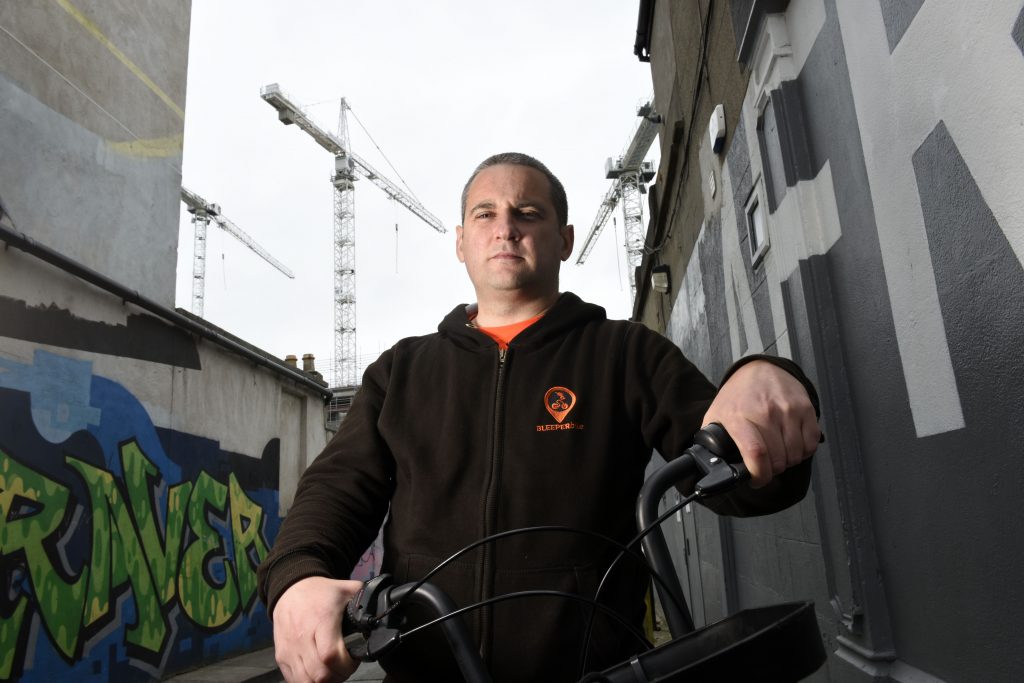
“Balbriggan to the Forty Foot is no longer a fantasy”
Bleeperbike, the stationless bike rental business, is one of the winners from the opening up of bike routes along the coast both North and South of the Liffey. The business which was founded by Hugh Cooney (pictured) showed The Currency a heat map of its bikes’ movements in July in Dún Laoghaire Rathdown County Council area and it is clear that the new coastal route is proving hugely popular for its users. “You can clearly see the popularity of Blackrock, Monkstown, Dún Laoghaire and the Forty Foot,” Cooney said. “We only just started operating in these villages in July so we expect the popularity to continue growing.” Cooney said he had allocated 25 bikes to the area, but would like to do more subject to receiving approval from DLRCC and UCD reopening. Cooney said he believed making towns and villages more accessible was a win-win for small business. “I cycled through Blackrock last Sunday and there were loads of people standing around, chatting, drinking coffee in the new pedestrian lane adjacent to the bike lane heading in the direction of the city centre,” he said. “I hadn’t ever seen that type of activity in Blackrock on a Sunday. It makes the village a destination that can compete with big-box shopping centres.” Cooney said initiatives in North Dublin too were of great interest to Bleeperbike. “We are already operating along the coast all the way up to Malahide, we would like to continue extending further north as more sections of the Fingal Coastal Way are completed,” he said. “The thought of being able to cycle along the coast all the way from Balbriggan to the Forty Foot is no longer a fantasy.” Bleeperbike is also looking at the corporate market, with a view to a full launch in early 2021. Kevin Cooney, no relation, recently joined the business from Australian financial services company Westpac Group. Kevin Cooney is working with the business on providing sustainable travel solutions to corporates, and on its general expansion plans.
DLRC, Burns says, is working on plans to bring people up from the coast into Dún Laoghaire town. “There are quiet streets which we could use to filter people up into the town. We need to do more work on it, but we have ideas.”
*****
Near the corner of Marine Parade and Marine Avenue is a half-moon shaped area. This has been a mini-car park for years. We stop there next. Burns says the plan is to turn this area into a pocket park. “Our idea is to put in some benches and plants here so people can sit here,” he said. “There could be a coffee concession here.”
Sandycove is per square foot one of Dublin’s most expensive areas. Will the wealthy residents fortunate to overlook the sea be happy with one-way routes?
“The first thing I’d say is just listen. Listen to the birds and sea. You can hear them now when you couldn’t before. This is how a residential area should be,” Burns responds.
Burns said a few residents had complained about driving in and out of their homes, but that small adjustments to the route had addressed these problems by giving them a little more space to drive in and out their gates.
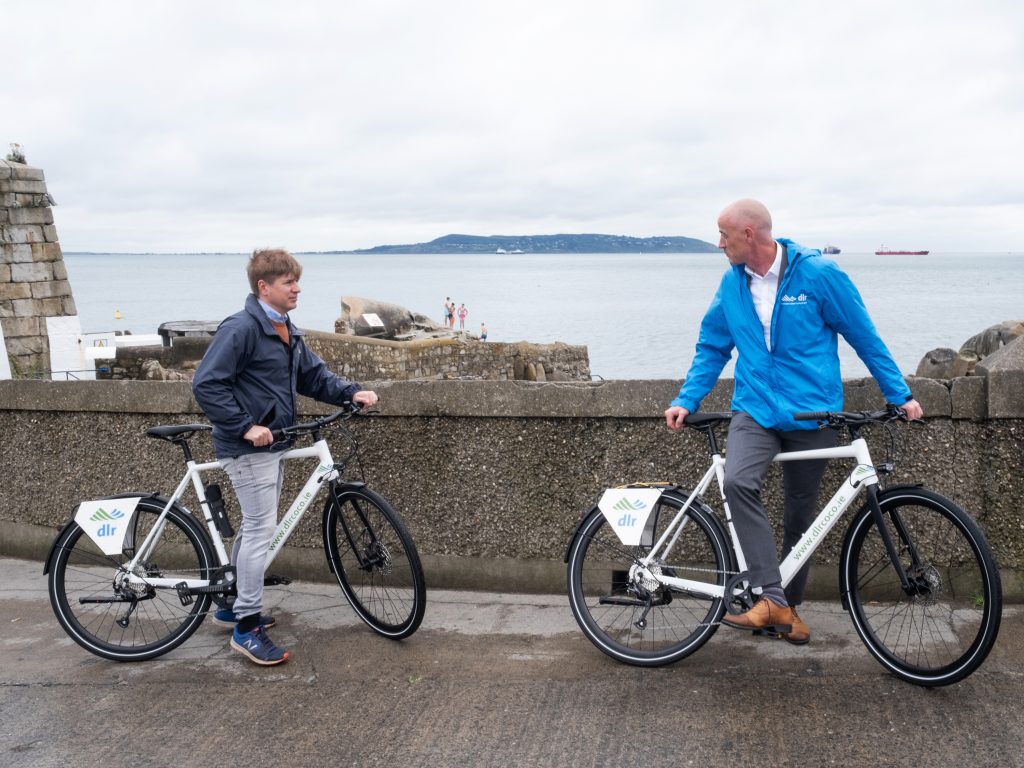
“People will decide if they want this permanently,” Burns says. “We will facilitate engagement. But at least now it is fairer. The people who advocated for years for change were at a disadvantage as you had to imagine what they wanted, versus the status quo people.
“Now we have a new experience for people. Hundreds of thousands of people are trying it, so the question is then do they want to go back to two-way traffic? Do motorists? Do residents?
“Will it go back when Covid-19 end? I don’t know. Will it be retained? I don’t know. We will facilitate a process and a discussion.”
Burns cannot say how long temporary is. “There is a real concern in the wintertime about Covid-19. This will help give us resilience as people can cycle and walk.”
“Think of all the young kids who have learned to cycle this summer,” he says. “They have built up their strength, their confidence and their cycling skills. They will want to keep cycling.”
Burns says part of the thinking around the mobility route is to allow children and teenagers to cycle to school. He says there are between 15 and 20 schools near the route that would benefit.
“You might not be able to get the full way to school but you can get very close to it. You might have to dismount and walk the last part,” he says. “Most parents, if they were given an active mobility option for their children to get to school, would use it.”
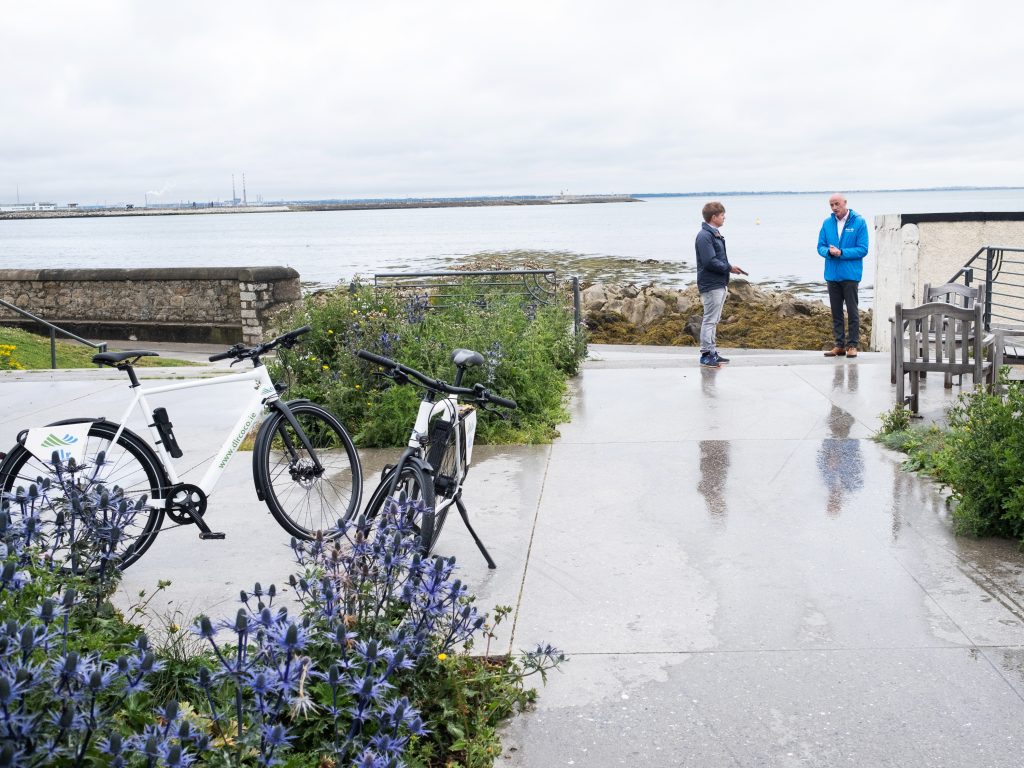
*****
We reach the Forty Foot after passing through a small permanent park in Sandycove. “This is the type of park we’d like to have more of,” Burns says as we pass through it.
At the Forty Foot, we hook around the famous Martello Tower, where the opening scene of James Joyce’s Ulysses is set.
DLRC began work in Dalkey in August to narrow its roadway and reallocate some parking spaces on its main route on Castle Street. Burns says relatively quiet streets lead up to Dalkey village, so there are no plans to implement major changes linking Sandcove to there.
“The plan, in the long run, is to link up with Bray and into Wicklow,” Burns says. “There is a plan and an ambition to do that.”
Instead of heading up to Dalkey, we turn back towards the village of Glasthule.
Burns says DLRC met up with businesses there three or four times to discuss plans for the village. Glasthule still allows two-way traffic, but the village has reclaimed many car parking spaces to allow businesses like Cavistons, a restaurant and gourmet food outlet, and 64 Wine, a wine shop and restaurant, to expand out onto the street.
“The footpaths were too narrow in Glasthule (to allow social distancing),” Burns says. He adds both 64 Wine and Cavistons plan to place tables in former car parking spaces to allow diners to eat outdoors.
Across the street, he says the Eagle House, which is part of the Loyola Group, is serving take-away food, coffee and pints. “We are helping them make a little outdoor area as well [in some former car parking spaces].”
As we stop in Glasthule, local businesspeople come up to chat to Burns. The feedback is good-natured, and most inquire about when the next phase of change is due. Nobody is complaining, but they are certainly engaged.
One thing that is planned for Glasthule is to close off one entrance to a car park that takes up a good chunk of the village to allow more outdoor seating.
We take a break at 64 Wines for a coffee served by the businesses’ owner Gerard Maguire. Maguire is married to Lucy Gaffney, the chair of Communicorp.
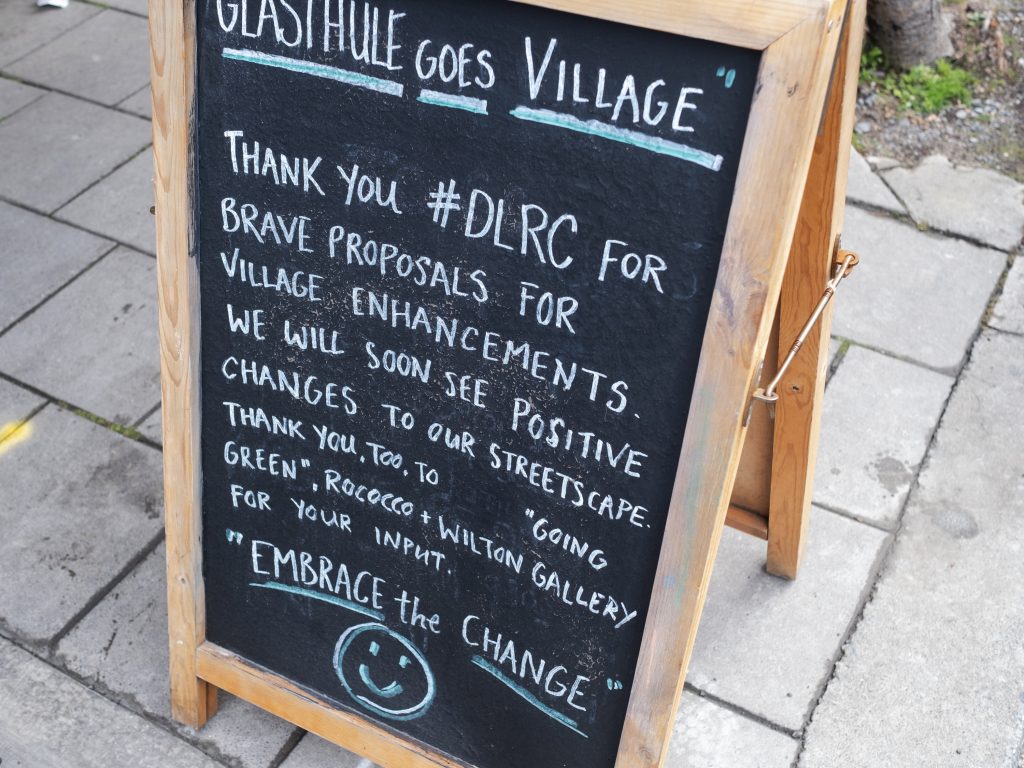
Communicorp banned The Currency from its various radio stations when we launched last September. Thankfully the restrictions do not extend to 64 Wine, which is one of the better venues in the village. Burns and Maguire chat about the logistics of using the street to dine al fresco.
After he leaves, I ask Burns about what it was like talking to small business owners at the start of Covid-19. “I was really concerned that people would start driving everywhere. But instead we had people walking and cycling and exploring their own area.”
Burns says DLRC was concerned that the sidewalks in places like Blackrock and Glasthule were too narrow for pedestrians to be able to pass each other. “So, we started taking back a few car parking spaces and it grew from there,” he says.
“We worked collaboratively with local communities and businesses. We developed an adaptive design model where we can go in first and put in the main items (like benches or plants). That way you can change it easily if that’s what people want.
“The success of Blackrock gave us momentum,” he adds. “We turned around a design for Blackrock in two weeks, and after three weeks were on site on June 7. We had the support of local businesses. For me leading it, I knew if I could get Blackrock working then other places would buy into it.”
Burns admits that usually, projects of this type would take months or even years of consultation, often leading to plans being watered down. “This was something we just had to get done,” Burns says. “It was like dealing with a fire or a burst pipe. We didn’t get to talk about it for weeks… we just had to do it.”
How much is it all costing? “We are still finalising the cost,” Burns says. “Blackrock is in the hundreds of thousands of euro but for a public realm scheme in terms of impact and value it is pretty good.
“For the coastal route the cost is probably about €2.5 million. There are about 4.5 kilometres of two-way cycle lanes. What would you pay for a road that same length? Cycle infrastructure is cheap.”
Burns says DLRC is working on additional plans for Dalkey and Dundrum and has plans to link the coastal villages to other routes. “Now we have unlocked the coast, it will be much easier to move inland.”
“If we were starting now would we get it done? I don’t know. That said, the Green Party leader (Eamon Ryan) is head of transport.” Burns says Ryan has identified investing more in active mobility as part of his goals as minister, so there would be more funding going into the area.
Two years ago, Burns says he toured the Netherlands as part of a cycling study group to learn about how they did things. “We are way behind. But I did see the way they do things as the future.”
The Dutch, he says, own more cars than ever. “They still use their cars for long distances and to go on holidays,” he said. “The Dutch, and the Danes too, are always trying to keep separate fast-moving large vehicles from vulnerable users.”
*****
We are now in Blackrock, having cycled along the coastal mobility route alongside Seapoint at the end of our journey. I have cycled along this route many times on the way to work in Dublin city centre.
It is usually a tricky proposition involving dodging around parked cars, while trying to avoid moving ones. Having a protected route is a much more pleasant and safer experience.
Blackrock is in one of Dublin’s wealthiest areas, but the village itself has never really taken off. It is dominated by large supermarkets at one end, and there is a Wetherspoons pub at the other.
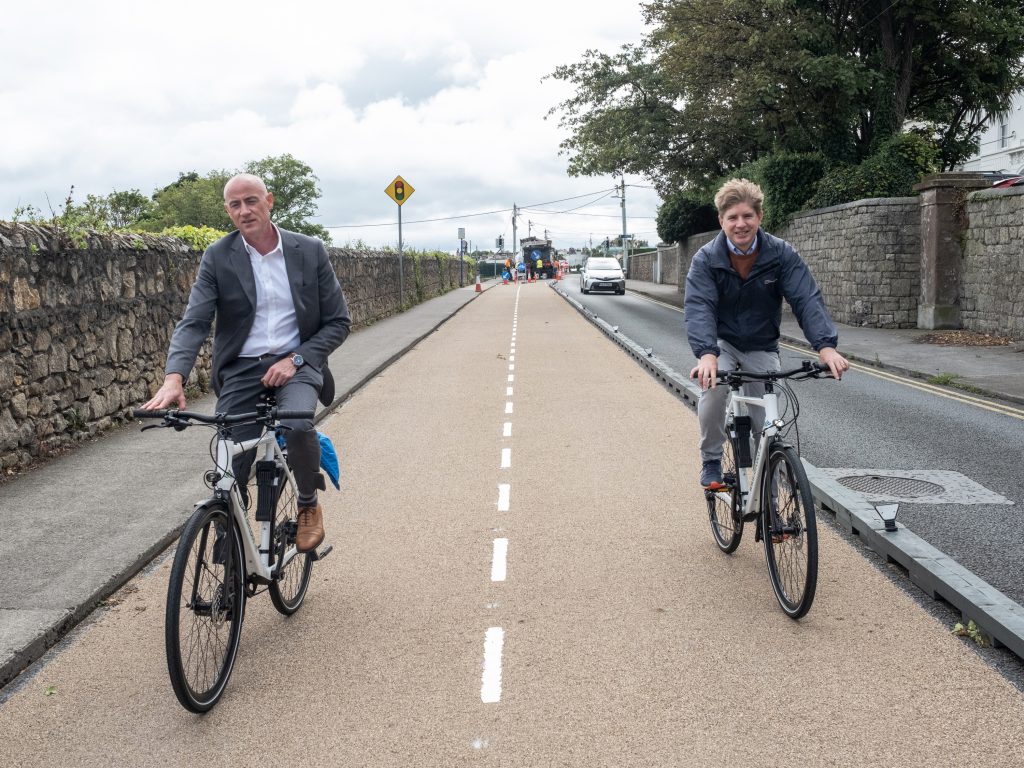
In between there are estate agents, pubs, restaurants, coffee shops, boutiques and beauty parlours. Some of these small businesses have been there for decades, but others come and go.
Up until recently the village only had one tree, Burns tells me. Now it has more than a dozen trees as well as other shrubbery and street furniture, as swathes of car parking has been turned into outdoor areas.
There is a cycle lane running through the village too, helping people stay away from the busy motorway on the other side of the village. There is still a good bit of work being done in the village, with about half a dozen contractors working there.
“We are making more improvements,” Burns says. “I will be able to bring people from other villages to Blackrock and show them what can be done.”
“Maybe the demand will come from other villages, and local businesses who like what they see,” he added.
“If we have more outbreaks of Covid-19 or another pandemic in the future, having wide public realms that allow people social distance will help our villages build resilience.”


